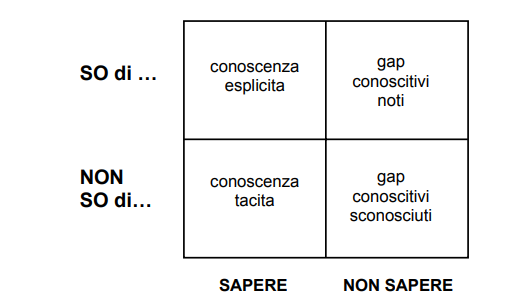Knowledge Management: the ally to prevent the loss of knowledge in the company
The generational turnover between Baby Boomers and Millennials is upon us and the transfer of knowledge, in terms of intellectual capital, is strategic for business continuity
The time is getting closer and closer when an entire generation, that of the so-called Baby Boomers , will withdraw from the labor market, causing Millennials to become the main players in the workforce. The stroke of retirement age of the generation that has so far moved the ranks of the business requires a more in-depth reflection than usual on what a usual "handover" could entail, having to do, in fact, with an intergenerational handover . among which there is only the brief interlude of generation X (1965-1980), very similar in characteristics, depending on the year of birth, to Boomers or Millennials.
Traditionally, the main metric in the company has always been the ROI (Return Of Investment), in reference to capital, but alongside this the time variable is something that has equal (if not greater) value, and time is inextricably linked knowledge .
As reported by a recent research by Field Service News recalled by the Italian company OverIT operating in the Field Service Management sector, companies have highlighted how the aging workforce , which reaches 73%, represents a major concern for their activities. These challenges stem from a shortage of skilled workers, a gap in practical skills, and the need to train many new hires.
The latter is accompanied by a previous research conducted a few years ago by the Sloan School of Management of MIT which highlights how new hires need on average more than 20 weeks to start working at their best (about 26 weeks for managers and managers) with a cost of up to 2.8% of total revenues.
If you think of all the changes that the business has made in recent years, you realize how the "loss of knowledge" represents a real cost for the business . Although the changing of the guard between Baby Boomers and Millennials is evident and imminent, it would not be entirely exhaustive to speak of a loss of know-how only in terms of retirements.
The world of work, like indeed all of today's society, is increasingly - with a widely abused word - "liquid" and for which personnel mobility is the order of the day, for the most varied reasons, obviously leading with own skills and knowledge.
Run for cover
Here, then, it becomes essential to talk about Knowledge Management (KM) . Broadly speaking, the concept can refer to the preservation and sharing of knowledge and has roots in antiquity with the development of libraries and communication tools.
The modern history of Knowledge Management, on the other hand, began in 1986 when the American scholar Karl Wiig coined the term and introduced its foundations during a conference organized by the International Workers' Organization of the United Nations.
From this moment on, the concept formalized in this way begins to interest many important companies, especially of a multinational nature, and will enjoy increasing attention, so much so that it is considered indispensable by many companies which have invested huge capitals in the creation of the infrastructures necessary for their implementation. .
Knowledge Management, therefore, is today a management practice in support of corporate strategy and has as its purpose the construction of widespread knowledge within the organization. In this regard, it requires an integrated approach that takes into account three categories of variables: people , processes and technologies .
This makes it possible to explain how, in fact, Knowledge Management focuses on the concept of knowledge, declining it in what scholars call "Intellectual capital" .
A definition of the latter is attributable to Thomas A. Stewart , executive director of the National Center for the Middle Market (NCMM), who states: “ Intelligence and knowledge become intellectual capital when a certain order is obtained from free brainpower useful, i.e. when it is given a coherent form (a mailing list, a database, a meeting schedule, a process description); when it is encapsulated in such a way that it can be described, communicated to others and exploited; and when it can be applied to do something that could not be done if it remained scattered like so many pennies in a gutter. Intellectual capital is packaged useful knowledge ”.
From this it is clear how knowledge is distributed across the various functions within the company. Furthermore, according to a contribution by Stefano Epifani , Daniele Biagiotti and Francesco Depaolantoni , intellectual capital “ is made up of the sum of its assets, made up of human capital, structural capital, relational capital ”.

Added to this is the fact that knowledge, in its various articulations such as those shown above, is presented in the two dimensions of the availability-absence of cognitive contents and their awareness-non-awareness .
Four possible intersections are thus generated to which they correspond: explicit knowledge (available and aware) to be disseminated after classification (mapping and archiving), tacit knowledge (available but not aware) to be made explicit through the exchange of information between the communities concerned (communites of practice) , known knowledge gaps (i.e. "what I don't know, but I know I don't know") to be covered by exploration (search engines, intelligent agents, filters) and unknown knowledge gaps ("what I don't know, and I don't know I don't know ”) to be discovered, for example, through machine learning expert systems.

Knowledge Management, then, must know how to manage the most valuable knowledge , i.e. the knowledge that an organization is able to collectively know , share and use effectively to generate value and for business growth. The previously mentioned triad (people, processes and technologies) also includes a reference to technologies, the element that today perhaps has more room for growth in terms of knowledge transfer.
For example, explicit knowledge can be expressed in text documents, emails, databases, web pages, etc. and can be more or less manageable depending on the level of formalization and structuring with which it is expressed: the higher the degree of structuring, the more powerful and expressive are the IT tools able to deal with it (for example, the technologies of the basic of data and data warehouses used in decision support applications).
The technological way
Furthermore, adopting the latest generation technologies is essential to bridge the gap between staff close to retirement, workers from other realities and young talent on the way.
These technologies include the concept of Knowledge Management, exploited through Augmented Reality and Artificial Intelligence . Always in line with what is reported by the aforementioned OverIT, Augmented Reality (AR) can be used through mobile devices such as smartphones, tablets, wearable devices (smart glasses) to present information in real time, such as digital work instructions, virtual checklists and interactive video calls.
Artificial Intelligence (AI), on the other hand, works with Augmented Reality to optimize the information presented to the user by providing data, images, videos or instructions "as needed". In this way, by making the two technologies work together, it will be possible to offer an intuitive, automated and interactive knowledge transfer.
It is clear how the benefits of integrating Knowledge Management functions within an enterprise impact on the rapid training of new team members (providing real-time guidance and information to newcomers with “on demand” knowledge which ensures workers to be trained anywhere, anytime, on site and without wasting resources); on the autonomy of field workers (remote assistance and guidance, even in environments with poor connectivity, AR annotations and real-time content sharing, digital work instructions, even offline, "on demand" knowledge, supported by the Artificial Intelligence) and offer, in general, continuous support , which can take the form of acquisition , sharing and archiving of essential data to be able to consult them when necessary, as well as, for example, automated data management.
Technology , therefore, plays a central role in the construction of solutions for the management of corporate intellectual capital, but it must always be remembered that it cannot stand as the only guarantee of success: a culture adequately oriented towards sharing knowledge , correct organization and a Appropriate leadership , availability and staff incentive systems are essential factors for the success of any Knowledge Management initiative, especially if it is generational in nature.
Some texts that could help you to learn more about the subject:
Knowledge management for business competitiveness. Models, tools, case studies
by Paola Paniccia
The Il Sole 24 ORE guide to Knowledge management
by Alberto F. De Toni and Andrea Fornasier
Corporate content management and knowledge management. New tools for competitive advantage
by Alessandro Zardini
also available in Kindle format
When you subscribe to the blog, we will send you an e-mail when there are new updates on the site so you wouldn't miss them.
By accepting you will be accessing a service provided by a third-party external to https://www.insightadv.it/



































































Comments